Very few personal trainers are qualified to operate as dietitians or registered nutritionists, so it is important to always work within the confines of your qualification and expertise. This is known as scope of practice and we will explore this later.
Personal trainers are not (generally) dietitians or registered nutritionists, so you must only offer simple guidance that aligns with official nutrition guidelines. You should now be comfortable reading the Ministry of Health (MoH) guidelines.
Building blocks: Macros and micros
Nutrition is the study of how food affects the body and its functions. Our food is made up of macronutrients (or macros) and micronutrients (or micros). Macros and micros are the terms we use to categorise the nutrients our bodies need for optimal health.
Macronutrients are the components of food that we need to consume in large amounts to provide energy and help our bodies grow and repair. The 3 main macronutrients are carbohydrates, proteins, and fats.
- Carbohydrates are the body's primary source of energy. They are found in bread, rice, pasta, fruits, and vegetables.
- Proteins are essential for building and repairing tissues in the body, such as muscles and organs. They are found in meat, fish, beans, and nuts.
- Fats are important for providing energy and insulating and protecting organs in the body. They are found in nuts, seeds, avocados, and oils.
- Alcohol is also a macronutrient as it does contain calories (7 calories per gram) and often additional carbohydrates (beer, wine, and cider). It can technically be used as a fuel source like carbohydrates and fat, though it is not recommended to consume alcohol as a source of energy and over-consumption of alcohol comes with a multitude of negative health consequences. Bear this in mind when discussing food and beverage intake with your clients as it may be the source of additional calories in their diet.
Micronutrients are the components of food that we need to consume in smaller amounts but are still essential for maintaining good health. The 2 main micronutrients are vitamins and minerals.
- Vitamins are organic compounds that are essential nutrients required in small amounts for bodily functions, such as building strong bones, boosting the immune system, and promoting healthy vision.
- Minerals are inorganic compounds that are essential nutrients required in small amounts for bodily functions, such as building strong bones, regulating blood pressure, and supporting muscle and nerve function.
Examples of micronutrients include vitamins A, C, D, and E, as well as minerals such as iron, calcium, and magnesium.
When planning your diet, it's important to consider both macros and micros to ensure a balanced mix of nutrients. Eating a variety of whole foods that are rich in these macronutrients and micronutrients can help you maintain good health and prevent nutrient deficiencies.
In this topic, we dig a little deeper into the components of food. You'll learn about:
- Carbohydrates
- Protein
- Fat
- Vitamins
- Minerals
- Hydration.
Carbohydrates (CHO) are the body's preferred, and most readily available, source of fuel. They usually provide the largest source of energy in our diet and act as the superior fuel source for the brain, blood cells, and muscle activity. They provide 4 calories or 17 kJ per gram.
Structure
Carbohydrates, or ‘carbs’, get their name from their chemical composition as they are made up of Carbon, Hydrogen and Oxygen (CHO). For example, glucose is a carbohydrate and you can see in the infographic it is simply made up of C, H, and O in either a ring or open-chain structure.
Glucose (also known as blood sugar or blood glucose) is a simple carbohydrate or monosaccharide (contains 1 sugar molecule). Other carbohydrates have repeating chains or rings of sugar molecules made of carbon, hydrogen, and oxygen.
What happens during metabolism?
When carbohydrates are metabolised, they are broken down into glucose (a sugar). The glucose is absorbed into the bloodstream and transported around the body via the blood vessels to be utilised as energy.
When glucose is not required for immediate use, it is stored by the liver as glycogen (the stored form of glucose). The process of the uptake of glucose into the cells requires the aid of insulin, and the release of glycogen stored by the liver cells requires the aid of glucagon (a hormone that stimulates the liver to release stored glucose) which is produced by the pancreas. The work performed by both insulin and glucagon ensures that the body, in particular, the brain, has a sufficient level of blood sugar. Should these levels rise or fall from optimal levels, symptoms, or disease states could occur.
Let's do a quick check-in.
There are 2 main types of carbohydrates - simple and complex. They each have unique structures, so they behave differently. Simple and complex carbs also differ in how quickly they are digested and absorbed.
Simple carbohydrates
Simple carbohydrates include monosaccharides and disaccharides.
Monosaccharides have 1 sugar molecule. They include:
- Glucose: Known in the blood as “blood sugar”. Glucose causes a rapid change in blood glucose levels when ingested. It combines with other molecules to form starch and glycogen.
- Fructose: The sweetest of all sugars and occurs naturally in fruit.
- Galactose: Important in the formation of milk sugar, otherwise not commonly found.
Disaccharides have 2 sugar molecules. They include:
- Sucrose: A combination of fructose and glucose. Better thought of as a simple sugar, e.g., table sugar - made from juices of sugar cane. It is found in many processed foods like milkshakes, cakes, and chocolate bars.
- Maltose: A combination of 2 glucose modules. It is found in rice milk, cereals, and vegetables.
- Lactose: A combination of galactose and glucose. It is found in milk.
These are often thought of as simple carbs due to the quick clearance/absorption rates in the gut. They have single bonds between sugar molecules.
Simple carbohydrate food examples: Dried fruit, fruit juices, sports drinks, soft drinks, milk, sugar, jam, honey, white rice, and products made from white flour such as white bread and white pasta. Simple carbohydrates can also be added to protein shakes!
Complex carbohydrates
Complex carbohydrates include oligosaccharides and polysaccharides. They have multiple bonds within long, complex chemical chains, which require more energy and effort to break down.
They contain glucose and other monosaccharides bound together.
- Glycogen: The stored form of glucose, stored as tightly packed glucose molecules.
- Starch: A complex carb often eaten via starchy foods like potatoes. Plant cells store glucose as starch and the human body converts the starch to glucose.
- Fibre: A structural part of the plant that can’t be broken down. Cellulose is a type of fibre. While it cannot be broken down, it plays an important role in digestion, supporting and maintaining the health of our digestive system. It is found in fruit, beans, grains, and legumes.
Complex carbohydrates food examples: brown pasta, rice, whole grain bread, whole wheat, breakfast cereal (oats, wheat germ, bran, etc.), fruits & vegetables, quinoa, and lentils.
Complex carbs take a longer time to digest than simple carbs. This means digesting complex carbohydrates releases glucose into the bloodstream much slower and more evenly than digesting simple carbs.
Watch
Not all complex carbohydrates are the same. Watch the video for an overview of simple and complex carbohydrates, and a comparison of starch and fibre. Answer the questions that follow.
Answer a quick round of true or false.
Starch and fibre are both polysaccharides, made up of 100s to 1000s of sugar molecules. They are both complex carbohydrates. They are both derived from plants but our bodies respond to starch and fibre differently. Compare the 2 types of complex carbohydrates.
Diets high in carbohydrates may lead to metabolic syndrome or insulin resistance. Symptoms include high blood sugar levels, high blood pressure, and increased waist circumference. This may result in an increased risk of cardiovascular disease and type 2 diabetes. As we touched on earlier, insulin is a hormone produced by the pancreas. It is incredibly important in the maintenance of optimal levels of blood sugar. During digestion, chemical signals are sent to the brain, which in turn lets other parts of the body know that food is arriving. This signalling process alerts the pancreas which then produces and releases insulin. Insulin, if stimulated or produced in the correct amounts, will then signal to the cells of the body to receive and accept the glucose that has arrived from our food.
Polysaccharides: Starch
High-starch foods include:
- Starchy vegetables like peas, corn, and potatoes
- Beans and lentils
- Grains including oats, barley, wheat, rice, pasta, bread, and crackers
Grains can be refined or whole. Whole grain is when the entire kernel is used, so includes all the nutrients grains have to offer. Whereas refined grains only include the endosperm (starchy part) - you miss out on vitamins and minerals.
Polysaccharides: Fibre
Fibre is an indigestible part of plant foods (not in animal products). It mostly passes through the intestines and is not digested.
The recommended daily intake (RDI) is 25 to 30g per day. Most Western adults don’t consume enough (15 – 20g) so any increase is beneficial. Fibre contributes positively to digestive health, can help you feel full after eating, and lower glycemic index. Good sources of dietary fibre:
- Beans, legumes, and lentils
- Fruits and vegetables with edible skin (e.g., apples) and edible seeds (e.g., berries)
- Whole grains (pasta, cereals, breads: > 3g fibre per serving)
Digestion
Digestion is a process where the body works to break down ingested food into the nutrients needed for health, growth, energy, and repair. Digestion starts at the mouth and ends at the anus.
Digestion pathway:
- The teeth and tongue work to mechanically break down food. Digestive enzymes in saliva work on carbohydrates. A small amount of glucose is absorbed in the mouth.
- The stomach has an acidic environment that breaks down food. It churns food through muscular movements called peristalsis. It also facilitates chemical digestion by secreting gastric juices that contain hydrochloric acid that kills bacteria and the enzyme pepsin that uncoils protein. Food ultimately becomes chyme (a watery, creamy paste).
- The small intestine is where the majority of the digestion of carbohydrates occurs. The presence of fibre, protein, and fat delay the digestion of carbohydrates.
- The liver has blood circulating throughout it. This is where the blood is cleaned, and glucose is stored as glycogen for later use.
- The large intestine (colon). Within 1-4hrs most sugars and starches have been digested. Fibre attracts water, softening the stools for passage without straining.
Absorption begins in the stomach with most nutrient absorption occurring in the small intestine. The walls of the small intestines are comprised of many folds of tissue layers. The many folds provide a large surface area for absorption.
Storage occurs in organs such as the stomach, a muscular sac within the abdominal cavity. The stomach stores food to give the body enough time to digest meals, particularly large meals, efficiently and effectively. The stomach also holds stomach acid (hydrochloric acid) and digestive enzymes which take part in the process of digestion as well as storage. The mouth is also a storage site as it holds the food until the teeth and the enzymes in the saliva have broken down food, making room for the next mouthful. Storage is also performed by other organs such as the gall bladder which stores bile (a substance that aids digestion) which is produced by the liver.
For every gram of carbohydrate stored in the body, 3 grams of water must also be stored. Therefore, relatively small amounts are stored in the body as:
- muscle glycogen (maximum of around 400g - this is dependent on muscle mass)
- liver glycogen (maximum of around 100g)
- excess stored as adipose tissue - once carbohydrate stores are full, excess circulating carbohydrate is converted to adipose tissue (body fat).
Watch
The following 14-minute video shows the digestion and absorption process of macro-nutrients within the body’s system. Pay close attention to the roles played by the organs of the digestive system. Being comfortable with this information, and translating this information to your clients will be of benefit to your skills as a fitness professional.
Glycemic index
We've compared starch and fibre previously and touched on the difference in glycemic index. Now it's time to look at it in more detail.
The glycemic index (GI) is a scale that ranks carbohydrates from zero to 100. The scale indicates the speed at which carbohydrates clear the gut and enter the bloodstream, effectively raising blood glucose levels. The higher the GI number the faster blood glucose rises after consuming a carbohydrate. There are 3 classifications for GI:
- Low: 55 or less
- Mid: 56 - 69
- High: 70+
Why is GI something we need to consider for health?
There are many reasons that we may want to follow a low-GI diet. According to the Glycaemic Index Foundation, following a low GI diet can help to manage diabetes and gestational (during pregnancy) diabetes by managing blood cholesterol, glucose levels, and reducing insulin resistance.
Following a low GI diet can help you achieve or maintain a healthy weight as this type of diet may help you manage your hunger and therefore not overeat. Other reasons to follow a low GI diet include improving your heart health, helping to maintain sustained energy levels, helping mental performance, and reducing the risk of some diseases like breast cancer and PCOS. It also could help reduce acne!
Use the GI search to identify the GI for the following foods. Would these foods be classified as low, mid, or high GI?
- White bread
- Boiled potatoes
- Underipe bananas
- Cooked quinoa

Not all carbohydrates clear the small intestine at the same rate. Carbohydrate clearance rates can be affected by several factors including:
- the structural nature of the carbohydrate (most complex carbohydrates tend to be slower releasing due to the increased number of bonds to break down).
- whether the carbohydrates were eaten in isolation or together with other macronutrients.
- the way carbohydrate-containing food is cooked/prepared.
When eaten in isolation most carbohydrates clear the gut relatively quickly. In general, complex carbohydrates will release more slowly than simple carbohydrates when eaten in isolation.
The addition of fat, fibre, or protein to meals can dramatically delay gastric (stomach) emptying rates, essentially slowing the speed of carbohydrate breakdown. For this reason, not all foods containing high amounts of simple carbohydrates will have the same effect on the system.
Expand the accordions to see examples of food with various GI values.
White wheat bread, donuts, baguette, crackers, waffles, white rice, boiled potatoes, french fries, watermelon.
Rye and wholegrain bread, muesli, corn, couscous, brown rice, spaghetti, popcorn, yams, ice cream, sweet yoghurt, banana, grapes, kiwifruit.
Coarse barley bread, strawberries, apples, pears, oranges, milk and soy milk, natural yoghurt, oatmeal, beans.
Pearled barley, lentils, grapefruit, cherries, apricot, plum, dark chocolate (70%), whole milk, cashews, walnuts.
Hummus, chickpeas, garlic, onion, green capsicum, aubergine (eggplant), broccoli, cabbage, tomatoes, mushrooms, lettuce.
Fast glucose release and the insulin response
There are some important issues when glucose is metabolised quickly. A rapid increase in blood glucose triggers an increased insulin response. This can cause rebound hypoglycemia (hunger symptoms).
When fast-releasing (high GI) carbohydrates are eaten and there is little demand for carbohydrates by the body (i.e. when resting), insulin will clear the bloodstream of excess glucose quickly by pushing glucose into fat cells. Increased circulating insulin can turn into stored fat.
When there is an active demand for glucose by the working muscles, glucose can circulate to working muscles and insulin will aid its entry into the muscle.
Review the image below for a visual overview of the effect on blood sugar levels between high and low GI foods.
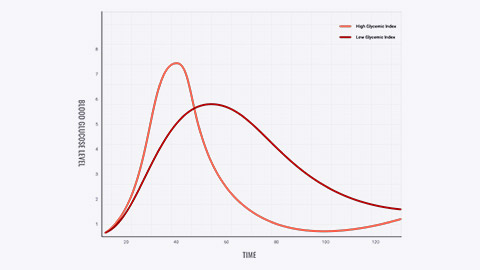
The graph illustrates the speed at which carbohydrates clear the gut and enter the bloodstream. High GI equals faster blood glucose rise. Complex carbohydrates are usually low GI and simple carbohydrates are usually high GI. However, this can change depending on what it is eaten with and how it is prepared.
GI selection and exercise
Carbohydrates are the body’s main source of energy, its ‘rocket fuel’. In particular, they power anaerobic and high-intensity exercise. As exercise intensity decreases, more fat can be utilised as energy.
Without a sufficient CHO supply, energy will begin to run low and it becomes difficult to push through a long training session and maximum capacity. The more intense the activity, the more carbohydrate is utilised as fuel. More fat can be utilised as a fuel source during a lower intensity training, but total calorie burn will be less. Therefore, as exercise intensity decreases, it can be assumed that the training zone moves towards fat burning rather than other training zones such as muscular speed or muscular hypertrophy.
Glycogen, the stored form of glucose, is the major source of energy to support the effective utilisation of ATP for activities lasting up to approximately 90 minutes. The muscles will use stored muscle glycogen first. The liver begins to release stored glucose (glycogen) to replace falling muscle glycogen. A decrease in liver glycogen stores can lead to a fall in the supply of blood glucose in the muscle. When blood can no longer supply working muscles with the necessary glucose to continue, fatigue sets in.
A body with full glycogen stores will fully deplete after approximately 2-3 hours of continuous training at low intensity (walking/jogging). However, when performing a high-intensity training session (applicable to most sports), muscle glycogen depletion can occur after as little as 15-30 mins. Once glycogen stores are depleted, an athlete can continue only at approximately 50% of maximum effort with mental and physical decline setting in. So, during longer spurts of physical activity (60-90mins or more), CHO replacement during exercise is essential. But during shorter spurts of physical activity (30mins – 1 hour), CHO replacement is not as important.
Other impacts observed when blood glucose level drops include impairment to brain function, coordination, light-headedness, and concentration. Therefore, it is essential that exercise prescription and nutrition are well balanced to support optimal training performance, physiological function, and recovery.

Pre-exercise
Consider how much time you or the client has before training. An early morning session may not leave much time to eat and sufficiently digest food. Therefore, something quickly absorbed for fast access to energy would be appropriate. Before advising this to a client, consider the pros and cons of this including aspects of glucose release, GI index, and carbohydrate structure.
Ideally, pre-exercise eating should begin 3-4 hours before exercise to allow sufficient time for optimal digestion and absorption. As the body has limited demand for carbs this far before an exercise, low GI carbohydrates would be most appropriate. This will allow glucose to enter the bloodstream in a time-release manner, helping avoid an insulin spike and allowing glucose to circulate to the "resting muscles". Insulin will still be produced and is essential to give glucose access to the muscle. Glucose will be stored as muscle glycogen for the upcoming exercise session.
Note: Some athletes don't handle fibre well in the pre-training window as it can cause stomach discomfort. In this case, starchy carbohydrates like potatoes, rice, white bread, etc. can be eaten. Combining them with a little lean protein will help slow down their absorption rate.
Post-exercise
The aim of eating after exercise is to optimise the restoration of muscle glycogen stores and repair what has been damaged through the ‘tear and repair’ theory, and replenish your body’s cells after their metabolic support. Post-exercise, muscle enzymes are especially receptive to storing carbohydrates as glycogen resulting in enhanced glucose acceptance by the muscles and glycogen storage becoming more active.
But the post-exercise hormonal environment (low insulin, high glucagon) is not optimal for getting glucose into cells where it can more beneficially be used to make glycogen. This is where the glycemic index comes in. To maximise glycogen synthesis, create an anabolic environment (high insulin). To maximise the insulin response, high GI carbohydrate is needed. Eating high GI foods within 2 hours of finishing exercise to replenish stores. Adding protein in combination with carbohydrates further increases the insulin response and glycogen storage.
Myth busting
So, carbs are broken down into sugar, right? Yup! So far, however, we have looked at the difference between high and low G.I carbs and the role that insulin plays, let’s now take a brief look at some of the myths behind sugars.
Fructose
Fruit contains the sweetest of all sugars, called fructose. Many people believe that this makes fruits a dangerous entity, especially for weight loss. A common misconception is that we shouldn’t be eating too much fruit because of this. Although fructose can be a dangerous source of calories, it isn’t the case when it is in fruit form. Natural fruit contains fibre and other vitamins and minerals which mediate the effects of fructose and are essential for a balanced diet. It is refined fructose that can cause issues.
Watch the 4-5 minute video for more information.
Carbohydrates consumption guidelines
*IMPORTANT NOTE - you will be using the following calculations to estimate carbohydrate requirements for your assessments in the Nutrition module."
When advising clients on the amounts of carbohydrates they can consume, it is all dependent on how active your client is. You can work this out with measuring the grams (g) of CHO against their body weight in kilograms (kg).
The following table provides suggested volume of daily carbohydrate intake dependant upon the volume of training performed per week. See the worked example for how to perform this calculation to better determine the appropriate daily carb intake for your clients.
| Hours of weekly exercise | Suggested daily carbohydrate/ weight ratio |
|---|---|
| Less than 4 hours | 3.5g/kg |
| 4-6 hours | 4.5g/kg |
| 7-9 hours | 5.5g/kg |
| 10-13 hours | 6.5g/kg |
| 14-20 hours | 7.5g/kg |
| 21-27 hours | 8.5g/kg |
| 28+ hours | 9.5g/kg |
Things to note:
- Traditional weight training is considerably less calorie intensive than continuous cardio, or team sports that are predominantly cardio-based.
- Circuit training or cross-fit is more calorie intensive than weightlifting.
- If more than 50% of training is weights, reduce gram/kg figure by 1g/kg from table figure.
- If over 75% of training is weights, reduce by 1.5g/kg.
- However, for someone participating in exercise or general daily activity, carbohydrate intake should be at a minimum 3g/kg body weight.
If the results of these calculations are a lot more than what a person is currently eating, slowly and progressively increase towards the calculated figures to allow clients a chance to gradually change processes and see the benefits the increased intakes afford them.
Client scenario: 1
Lou is your new client and has asked you to help them determine their optimal carb intake for their general exercise routine. What information would you need from Lou to calculate their daily CHO intake using the table above?
- You'll need Lou's weight and how many hours per week they will be training.
Lou weighs 65kg and does 8 hours of meaningful training a week. According to the table above, Lou should be taking in approximately 5.5g of carbohydrates per kilogram of body weight; what does this look like on a daily basis?
Their recommended daily carbohydrate intake is:
- 65kg X 5.5g = 357.5g CHO/day
Client scenario: 2
Client scenario: 3
John weighs 90kg and does 3 hours of training a week 50% of this is weights, and his goal is to lose 5kg.
With this goal weight of 85kg, and based on his training sessions, his recommended daily carbohydrate intake is:
85kg X 3g = 255g per day
Did you know?
Many athletes significantly under-eat carbohydrates, often in favour of protein.
If minimal weight loss is desired (i.e. 2-5kg). You can use the desired weight in the equations to create a larger calorie deficit. These equations, however, are not relevant for obese populations. With larger amounts of weight loss (10kg+), we will need to use a different approach.
Carbohydrate needs for exercise
Pre-exercise carbohydrate:
- 100-200g mainly complex CHO in the 3-4 hour period before training or competing. The amount depends on the intensity and duration of exercise to come and also the size of the athlete.
- The closer it gets to performing and exercise, move towards eating medium/higher GI foods.
- If less than 30 minutes before exercise starts, stick to liquids, and fast-absorbing carbohydrates.
During exercise:
- 30-60g/hour for strenuous activities lasting more than 1 hour. This helps to spare liver glycogen stores for future activity needs.
- Begin ingestion after the first hour. Must be simple CHO and low fat.
- The easiest form is obviously fluid, but can also use easily absorbed bars and gels.
Post-exercise:
- It comes highly recommended to plan a post-exercise meal to be 1g/kg of body weight of CHO and 20-30g protein within an hour for best results.
- Carbohydrates and protein consumed together seem best to create a desired insulin response to shuttle nutrients to muscles that are demanding food.
- It is fine to consume any type of CHO, it is OK to use high GI foods.
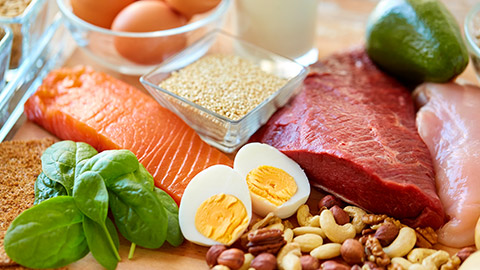
Protein is an important macronutrient our body needs to repair, grow, and maintain its tissues. It's essentially the building block of our body. Some proteins in our body produce enzymes that help digestion, while others help transport oxygen through our bloodstream. You can find protein in many foods such as meat, fish, eggs, beans, tofu, nuts and seeds, and even new grain options on the market like high protein breads or legume/bean-base pastas. Proteins provide 4 calories (kcal) or 17 kilojoules (kJ) per gram. So, consuming 1 gram of protein will provide 4 calories or 17 kilojoules of energy.
Structure
Proteins like hemoglobin, insulin, collagen, and myosin have a specific shape that helps them do their jobs in the body. This shape is determined by how their amino acids (the building blocks of proteins) are arranged. There are 20 different amino acids that can be combined in different ways to form an almost infinite number of unique protein structures.
The first level of protein structure is the primary structure, which is the specific sequence of amino acids that make up the protein. The secondary structure is the way the amino acids fold and interact with each other to form either an alpha helix or a beta sheet. The tertiary structure is the overall 3D shape of the protein, which is determined by the interactions between the amino acids and other factors like the surrounding environment. The quaternary structure is how multiple protein subunits come together to form a functional protein complex, like hemoglobin.
So, proteins each have a unique arrangement of amino acids that determine their primary, secondary, tertiary, and quaternary structure. This ultimately affects their function in the body.
We can look at the structure of hemoglobin to understand the relationship between amino acids, structure, and function.
Hemoglobin is a protein made up of 4 subunits, each with its own primary structure (a linear chain of amino acids). The secondary structure of each subunit includes both alpha-helices and beta-sheets. The tertiary structure is the 3D arrangement of the subunits, which allows hemoglobin to carry oxygen. Finally, the quaternary structure is the overall arrangement of the four subunits, which further contributes to hemoglobin's ability to bind to oxygen.
Watch
Watch Hank Green from the SciShow explain protein in less than 5 minutes. This video explains the types of amino acids (essential, non-essential, and conditionally essential), why eating protein is important, and how exercise relates.
Complete vs incomplete proteins
A complete protein contains all of the 9 essential amino acids the human body requires in sufficient amounts. The body cannot produce these essential amino acids, so they must be obtained from the diet. Complete protein sources include animal products like meat, poultry, fish, eggs, and dairy.
On the other hand, an incomplete protein is a protein source that does not contain all 9 essential amino acids in sufficient amounts. These protein sources often come from plant-based foods like beans, grains, and nuts. However, by combining different incomplete protein sources that complement each other, such as rice and beans, you can obtain all nine essential amino acids and create a complete protein meal.
What happens when we eat protein?
Protein is digested, absorbed, and stored.
Digestion
Digestion is the process of breaking down the food we eat into nutrients our bodies can use for growth, energy, and repair. It starts in the mouth and ends in the anus. Saliva in our mouth helps to make food soluble and easy to swallow while our teeth mechanically break it down.
In the stomach, proteins are broken down (uncoiled) into smaller chains of amino acids by hydrochloric acid and enzymes like pepsin, aided by muscular contractions.
Absorption
Protein absorption occurs in the duodenum or proximal jejunum of the small intestine. The peptides and amino acids pass through the interstitial brush border by facilitative diffusion or active transport. Active transport is when molecules are moved against their concentration gradient using energy, usually from ATP.
Once absorbed, amino acids or peptides are released into the intestinal bloodstream and transported to the liver, where they are stored in amino acid pools. Next, the amino acids are converted into enzymes, hormones, and muscle protein. When other energy stores run out, amino acids can be used for energy.
Different protein-containing foods are absorbed in different rates. Animal protein has a high absorption rate, whereas plant protein has a low absorption rate.
Storage
Once the protein has been digested and absorbed, it must be stored. Protein is stored in the liver, muscles, and adipose tissue (body fat).
- The liver stores amino acids in "amino acid pools," which can be used for enzyme, hormone, and muscle repair.
- Approximately 50% of stored protein is located in muscles and is used for structural tissues like skin and bone.
- Excess protein intake is stored in adipose tissue.
Watch
In this video, you'll see a visual representation for the process of protein digestion and absorption.
High protein diets
When considering a high-protein diet, it's important to think about energy and its effect on the kidneys.
- Energy: Where do we get energy from? Will extra protein really help your performance? Protein is filling and may prevent the consumption of carbohydrates. During exercise, if carbohydrates run out, protein stores could be used for energy resulting in lean body mass reduction.
- Kidneys: You will need to urinate more often to excrete excess nitrogen. This may put a strain on the kidneys.
Before making adjustments to increase dietary protein levels, consider the following factors:
- Weight loss: Protein provides us with the feeling of being full. This is called satiety. When consumed in appropriate amounts, it can lead to fewer total calories, which may result in weight loss.
- Weight gain: While some foods can be high in protein, they can also be high in fat. If this is the case, it may lead to excess calorie intake, resulting in weight gain.
- Calcium excretion: Diets high in protein can lead to calcium excretion in the form of extra urination. The extra urination takes place to remove excess nitrogen, which can then deplete key electrolytes, including calcium. This may lead in bone density reduction.
- Raised cholesterol levels: Animal products, while high in protein, can also be higher in cholesterol, which could play a role in heart disease.
Consuming more protein does not speed up muscle growth. "The more you eat the more you grow" is not true. The law of diminishing returns applies here!
Low protein diet
Low protein diets can have serious implications on the body. What happens when we don't get enough protein?
- Stunted growth occurs from implications of the repair of muscles. Not only can it delay growth but it can also prevent it.
- Oedema, identified by swollen and puffy skin, is also a classic symptom of kwashiorkor (a form of severe protein malnutrition).
- Skin, hair, and nail deficiencies. Low protein levels can cause redness, flaky skin, and depigmentation also resulting in weak nails and hair loss.
- Loss of muscle mass is typically due to less protein being available for muscular repair and if protein has been used as a backup fuel source.
- Greater risk of bone fractures. This occurs as the density and strength of the bones diminishes.
- Increased severity of infections. The body’s immune system becomes weakened by a lack of antibodies.
- Fatty liver, an accumulation of fat within the liver. If this is left untreated, it can lead to fatty liver disease.
Amount of protein required
Calculating the required amount of protein depends on the individual’s weight (measured in kilograms, kg), physical training or activity, and personal goals. Protein is a minor fuel source, primarily used during endurance exercise when carbohydrates run out. Protein is primarily needed for repair of lean body tissue that can be damaged during training.
Protein needs vary and specific groups require extra protein depending on their lifestyle, e.g., sportspeople, people who are pregnant, children, and adolescents. Children and adolescents are growing at an accelerated rate and experience growth spurts. Therefore, they must receive more protein to keep up with the rate at which they are growing. For people not partaking in any exercise, 0.8g/kg of body weight per day is sufficient.
Determine the following before making any calculations for protein requirements:
- What type of training is performed?
- How often is it performed?
- What is your client's current weight?
- What is your client's goal weight?
Protein consumption guidelines
The following are generalised daily protein recommendations.
| Client profile | Suggested daily protein/weight ratio |
|---|---|
| General population (doing some fitness) | 1g/Kg |
| Child | 2g/Kg |
| Adolescent athlete | 2g/Kg |
| Strength (doing 4 or more weight sessions per week) | 1.6-1.7g/Kg |
| Strength (doing 3 or fewer weight sessions per week or mixed training) | 1.3-1.5g/Kg |
| Endurance (doing only endurance) e.g., cyclist, runner, long distance swimmer | 1.2-1.4g/Kg |
| Pregnant | 1-1.2g/Kg |
| Adult | 0.8g/Kg |
Client scenario: 1
Client scenario: 2
Wiremu is a 32-year-old strength athlete who competes in provincial powerlifting competitions multiple times throughout the year. He regularly trains 4 – 5 hours per week, performing heavy compound lifts as well as additional light cardio on the side (2 hours per week).
Wiremu weighs 90kgs, so his suggested daily protein intake would be 1.6-1.7g of protein per kg bodyweight, in grams he would aim for 144 – 153g of protein per day.
Client scenario: 3
Aroha partakes in a mixture of training sessions, running 3 times a week (45 minutes to 1 hour each run) as well as attending Olympic weightlifting sessions at her local gym twice per week.
Her goal is to lose some weight while maintaining her strength. Her weight goal is 65kg (she is currently 70kg).
Based on this information, Aroha is aiming for 1.5g/kg of protein- a total of approximately 98g per day (65kg x 1.5g/kg).
Protein consumption and exercise

Most daily food intakes contain well above the recommended requirement for protein.
Filling up on protein in the pre-exercise window may reduce appetite because the body's preferred fuel for training is carbs. This may negatively impact exercise performance. A small amount of protein in the pre-event meal will help with satiety (fullness).
Post-training (or post-event) meals should include some protein. This can help to restore muscle glycogen levels, repair muscle tissue, and may help encourage gain in lean body mass. 20-30g of protein in a post-training meal is sufficient. There is little evidence to suggest that consuming more than 30g of protein in one sitting gives additional benefits unless the client carries large amounts of additional muscle mass.
Spreading your protein intake out throughout the day can help improve muscle protein synthesis and muscle growth and may be easier on the stomach.
Protein is an important macronutrient to help build muscle and many other structures throughout the body. We can get most of the protein we need throughout the day simply by giving some thought to our food choices. Protein supplements are unnecessary but can be helpful for those:
- in a calorie deficit.
- that have very high protein needs for recovery and muscle growth.
- that are vegan or vegetarian.
- that are athletes and find it difficult to achieve protein requirements through food alone.

Fat is the most abundant storage form of energy in the body. Fat is an insulator and helps transport and store fat-soluble vitamins. Fat provides 9 calories (or 37 kJ) per gram.
Structure
Fats (also called triglycerides) have a unique structure and are made up of a glycerol molecule and 3 fatty acids. The glycerol molecule is a 3-carbon alcohol with a hydroxyl group (-OH) attached to each carbon. Fatty acids are long chains of carbon and hydrogen atoms with a carboxyl group (-COOH) at one end.
Fatty acids are long chains of carbon atoms with hydrogen atoms attached, and they have a carboxyl group (-COOH) at one end. These chains can be either saturated (with all carbon atoms bonded to hydrogen atoms) or unsaturated (with some double bonds between carbon atoms). Saturated fats are solid at room temperature and are commonly found in animal products like butter, cheese, and fatty meats. Unsaturated fats are liquid at room temperature and are found in plant-based foods like nuts, seeds, and oils.
Lipids
Fats are lipids. Lipids are organic compounds that are insoluble in water. They include fats, waxes, oils, hormones, and certain components of membranes and function as energy-storage molecules and chemical messengers. Lipids are hydrophobic or "water-fearing" due to the long hydrocarbon chains of fatty acids.
Lipids include:
- Triglycerides (the stored form of fat in adipose tissue)
- Fatty acids (simple form of fat)
- Phospholipids (the main structural component of cell membranes)
- Sterols (helps sustain the structure of a cell membrane)
- Cholesterol (fat in the blood)
- Lipoproteins (transports cholesterol through the bloodstream and cellular fluid)
Types of fats
Glycerol molecules are all the same, but fatty acids vary in chain length, degree of saturation (single vs double bonds), and shape. These differences in the structure determine whether a fat is saturated or unsaturated, cis or trans, and monosaturated or polyunsaturated.
Let’s learn more about fat types and their structures in the following 4-5 minute video.
The major classes of fat found in food are saturated fat, monounsaturated fat, polyunsaturated fat, and trans fat. Some are more beneficial to the health of the human body than others. Statement 2 from the MoH guidelines is to choose and prepare food and drinks with unsaturated fats, instead of saturated fats. This is a simplified statement because as you have just learned, trans fats are a type of unsaturated fat. When most people refer to unsaturated fats (mono and poly), they are referring to cis-unsaturated fats. Trans-unsaturated fats are often simply referred to as trans fats.
Saturated fat
Saturated fats contain saturated fatty acids. This means that fatty acids only contain single bonds between carbon atoms. This forms a tight structure that stacks on itself. Food that contains mostly saturated fats include:
- Butter
- Red meat
- Coconut
Most plant foods contain mostly unsaturated fats, but coconut actually contains about 90% saturated fats.
Certain saturated fats are known to increase total blood cholesterol and low-density lipoprotein (LDL) cholesterol, which can lead to atherosclerosis (narrowing of arteries) and coronary heart disease. Surplus cholesterol in the blood is often deposited on the artery walls (plaque) leading to the narrowing of the arteries, angina, heart attacks, and stroke.
The Heart Foundation NZ has produced a short video explaining risk associated with high cholesterol.
Saturated fats are typically solid at room temperature, making them easy to spot and remove, e.g., cutting away the lard (fat) on a steak. The texture of saturated fats has a smooth waxy-like substance important in cell membranes. It is stored in the adrenal glands, ovaries, and testes and is used to make adrenaline and steroid hormones.
Monounsaturated fat
Monounsaturated fats (MUFAs) have one double-bonded carbon molecule (an unsaturated carbon atom). They are found in nuts, seeds, vegetable oils, and avocados. Plant foods contain mostly monounsaturated fats.
Monounsaturated fats are considered a healthy choice because they can help improve cholesterol levels and reduce the risk of heart disease. They do this by lowering LDL (bad) cholesterol levels and increasing HDL (good) cholesterol levels. Additionally, they are a good source of vitamin E, an important antioxidant that helps protect cells from damage.
Some examples of foods that are high in monounsaturated fats include:
- Olive oil
- Canola oil
- Avocado
- Nuts (such as almonds, peanuts, and cashews)
- Seeds (such as sesame and pumpkin seeds)
- Peanut butter
It's important to remember that while monounsaturated fats are a healthy choice, they are still high in calories. Therefore, it's important to consume them in moderation as part of a balanced diet that includes a variety of foods.
Polyunsaturated fats
Polyunsaturated fats (PUFAs) have more than one double bond. They are considered healthy for the body and contain essential fatty acids that the body needs but cannot produce. They are found in a variety of foods, including fish, nuts, seeds, and vegetable oils.
Polyunsaturated fats are considered healthy because they contain omega-3 and omega-6 fatty acids, which are important for the body but cannot be produced by the body and must be obtained through the diet. Omega-3 fatty acids are important for heart health, reducing inflammation, and supporting brain health.
Some examples of foods that are high in polyunsaturated fats include:
- Fatty fish (such as salmon, tuna, and mackerel)
- Flaxseeds
- Chia seeds
- Walnuts
- Soybeans and soy products (such as tofu and soy milk)
- Corn and sunflower oils
It's important to remember that like all fats, polyunsaturated fats are high in calories and should be consumed in moderation as part of a balanced diet. A diet that includes a variety of foods is important to ensure that you get all the nutrients your body needs to function properly.
Trans fats
Trans fats are a bit more complicated. They are technically unnatural and were created by the food industry from mono and polyunsaturated fats to make fat more saturated. This helps food products maintain shape and appearance. Trans fats are often found in processed foods like baked goods, fried foods, and snack foods like chips and crackers. They are also found in some margarines and shortenings.
Trans fats are considered to be unhealthy for the body. They are created through a process called hydrogenation, which turns liquid vegetable oils into solid fats.
As a personal trainer, it's important to understand that trans fats are considered to be one of the most unhealthy types of fat because they can increase LDL (bad) cholesterol levels and decrease HDL (good) cholesterol levels in the body. This can increase the risk of heart disease, stroke, and other health problems.
It's important to note that in recent years, many food manufacturers have taken steps to reduce or eliminate trans fats from their products. It's still important to read food labels carefully to reduce or eliminate trans fats. As a personal trainer, follow the MoH guidelines and encourage clients to focus on whole, unprocessed foods and cooking with healthy oils, such as olive or canola oil.
Watch the video for a look at how trans fats came to be and why they are considered unhealthy.
The tables below summarise the types of fat and how they react in the human body.
| Saturated fat | Trans fat | |
|---|---|---|
| Effects on the body | Raises total blood cholesterol levels and LDL cholesterol levels. | Raises LDL cholesterol and lowers HDL cholesterol. |
| Dietary Sources | Animal sources of food. | Present naturally at low levels in some food. Found in processed food, margarines and shortenings. |
| Examples of foods | Fatty cuts of meats, sausages, ghee, butter, cheese, pastries, full-cream dairy products, coconut milk/oil, and palm kernel oil. | Hydrogenated vegetable oil, shortenings, pies and pastries, commercial cakes and biscuits, and deep-fried foods. |
| Monounsaturated fatty acids | Polyunsaturated fatty acids | |
|---|---|---|
| Effects on the body | Maintains HDL cholesterol level while reducing the levels of LDL cholesterol. | Lowers the level of LDL cholesterol. |
| Dietary Sources | Found in a variety of plant food and oils. | Oily fish and plants. |
| Examples of foods | Vegetable oils (e.g., olive oil, sunflower oil, peanut oil, corn oil, rapeseed oil, canola oil), nuts (e.g., hazelnuts, almonds, cashew nuts, Brazil nuts, peanuts), and avocados. | Fish: Salmon, tuna, trout, mackerel, sardines, herring. Plant: Flaxseed (ground and oils), soybean oils, walnuts, butternuts, sunflower seeds. |
Digestion
Let’s take a look what happens to fat through digestion.
- The stomach has a churning action (peristalsis) that mixes the fat, water and acid.
- The majority of digestion and absorption of fats occurs within the small intestine. The pancreas produces enzymes and the liver produces bile which are delivered to the small intestine and breaks down the fat. The bile will help emulsify the fat and the enzymes will hydrolyse the triglycerides.
- Fat and cholesterol trapped in fibre exit in solid waste through the large intestine. Approximately 5% of fat gets excreted, while the remaining 95% gets absorbed and stored.
The following image shows the process of digestion of fat within the body.
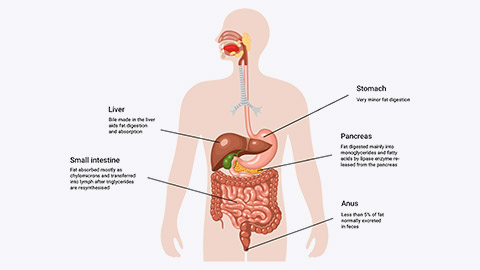
Absorption
Once the enzymes and bile digest and emulsify the fat into monoglycerides and free fatty acids, they get transported to the cell walls of the small intestine where they are absorbed and transformed into particles named chylomicrons (small fat molecules).
Larger molecules are packed into transport vehicles called chylomicrons. Cells release these chylomicrons into the lymphatic system. From the lymph, they move into the bloodstream where they are used for various functions including energy, cell repair, and growth.
Excess fat deposits are stored in adipose tissue (body fat).
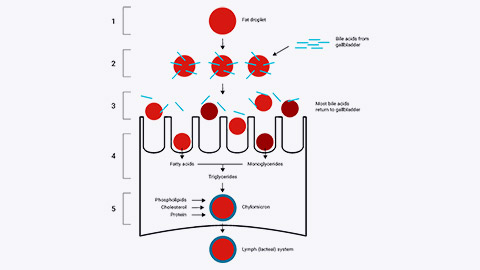
Storage
Fat is stored:
- In subcutaneous adipose (fat under skin) cells and visceral deposits (around vital organs).
- In muscle as an intramuscular triglyceride.
- As structural components for a variety of cells.
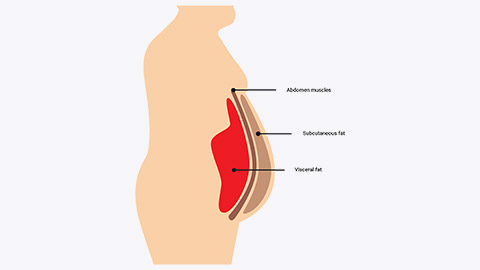
Fat consumption guidelines
General dietary recommendations suggest that a healthy adult should have a total daily fat intake of 20 - 35% of total energy intake.
- Saturated fats and trans fats should be below 10%
- Monosaturated fats between 10 - 20%
- Polyunsaturated fats between 6 - 12%
The average intake in New Zealand is 33% fat, which equates to 95g for men and 67g for women.
Most active people can maintain body-fat working on a recommended intake of 1g/kg of body weight. E.g., An 85kg male could have up to 85g fat per training day. Of course, if body fat reduction was a goal, this could be decreased by 15%.
| Client goals | Suggested daily fat in grams |
|---|---|
| Maintain weight | 1g/kg |
| Lose weight | 0.85g/kg |
| Gain weight | 1.15g/kg |
Calculating calorie content of fat on labels
Let's look at nutritional labels on food products and calculate the percentage of calories gained from fat for a standard serving/portion size.
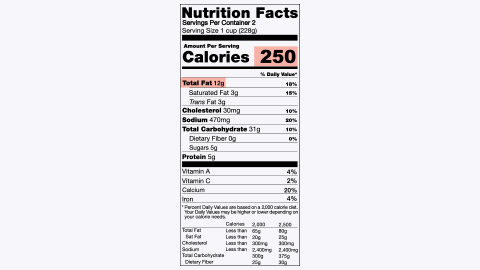
Review and practice the steps below, using the labels above, to calculate the percentage calorie contribution from fats. Once you are comfortable with the steps below, look at labels around your home and see if there are any surprises in your cupboard.
When reading a nutritional label, it is important to note that each nutrition label indicates a serving size. Be mindful of the serving size versus container size per container.
- Determine calories per serving, e.g., 250 calories
- Determine the grams of total fat, e.g., 12 grams/serve
- Calculate total calorie intake from fat. Remember, there are 9 calories in a gram of fat. Total calories from fat = 12 x 9 = 108 calories per serve
- Calculate the percentage intake of calories from fat. Percentage intake = total calories from fat ÷ calories per serving x 100 = 108 ÷ 250 x 100 = 43.2%

Fat and exercise
Think back to our energy balance equation.
- Energy in = Calories (kilojoules) consumed through everything we eat and drink
- Energy out = Energy used for metabolic processes such as BMR, TEF, and extra activity, including non-exercise activity thermogenesis and exercise.
We are not always eating, so we need to be able to store fuel for later use.
We know we can store glucose as glycogen in the liver and muscles, and we store amino acids (protein) in the muscles, so we must also be able to store fat. We store fatty acids in adipocytes (fat cells).
Fat has most of the body’s stored energy, providing more than half of the energy required, even more than carbohydrates or proteins. This is why your body keeps fat in reserve.
The more free fatty acids (FFA’s) that are released from adipose tissue (fatty tissue) into blood, the more fat will be used by the muscles. As the exercise becomes increasingly prolonged, fat usage increases (as does carbohydrate). The more trained a muscle is, the greater its ability to use fat as fuel. Therefore, exercise increases our ability to utilise fat as fuel. Fat metabolism requires a continuous oxygen supply, so fat is mostly burned during aerobic exercise.
See a comparison below of 2 different types of exercises and how they each utilise different amounts of energy from fats and CHO.
- Walking burns 60% fat, with 40% coming from Carbohydrates (CHO)
- Running (10 km/hr) burns 30% fat and 70% Carbohydrates (CHO)
This does not necessarily mean more fat is burnt by walking than by running. However, it highlights that exercise intensity influences fat use as a fuel. The total amount of calories burned is also important. Running burns more total calories, so even if less fat is burned as a percentage of fuel, more total fat calories could still be burned than walking. While walking burns more fat as a percentage of fuel, running burns more total calories and for that reason, it burns more total fat calories. See the following example for 20 minutes of exercise:
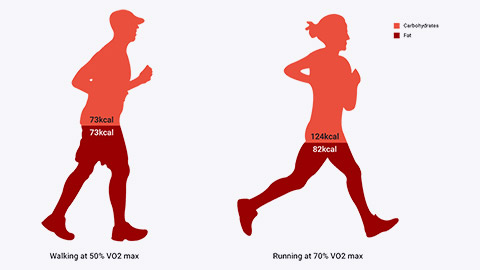
Fats should be consumed sparingly before exercise of any intensity due to little chance of depletion and slow absorption. Fat is slow to digest and cannot be “refuelled” during an event. The storage of fat in our muscles does provide a source of energy. However, it is generally used in conjunction with carbohydrates (CHO).
Eating in small portions throughout the day is suggested, but avoid fat in the lead-up to, during, and immediately after exercise. Fat will slow the absorption of other nutrients (e.g., CHO) needed in the pre-exercise window. It will also blunt the insulin response post-training, interfering with muscle replenishment of CHO and protein absorption.
Interestingly, fat is used differently during exercise for people that are fit and those that are unfit. When an individual is fit, their body is well-equipped to utilise fat as a fuel source.
Now that we have learnt about the importance of each macronutrient, we can put this information to use to calculate total daily calorie intake and macronutrient ratios.
In summary:
- Carbohydrates and protein contain approximately 4 calories per gram
- Fat contains approximately 9 calories per gram
- Alcohol contains approximately 7 calories per gram
- To calculate macronutrients, we need to look at a person’s bodyweight, activity level, type of activity, and bodyweight goals.
- We can use this information to ESTIMATE somebody’s macronutrient and calorie needs.
- If somebody falls outside of a personal trainer’s scope of practice for nutrition, we should refer to a nutrition professional.
Now let us look at some examples.
Calculate your own macronutrients
Using the formulas on this Excel spreadsheet Client Calculation resource, calculate your own estimated macronutrient and calorie intake based on your activity level, weight, type of activity, and goals. See the video below for guidance:
Watch
Vitamins are essential micronutrients that play a crucial role in maintaining optimal health and performance. There are approximately 13 different vitamins that sit within the groups vitamin A, B, C, D, E, and K. They have different roles that vary from blood clotting procedures to helping resist infection. Vitamins are essential in trace amounts for metabolic reactions.
Structure
The structure of vitamins can vary widely, but most are composed of carbon, hydrogen, and oxygen atoms, with some also containing nitrogen, sulfur, or other elements. Vitamins are classified into 2 main categories: fat-soluble and water-soluble.
- Fat-soluble vitamins, including vitamins A, D, E, and K, are stored in the body's fat tissues and can accumulate to toxic levels if consumed in excess. These vitamins are important for many bodily functions, including vision, bone health, and immune function.
- Water-soluble vitamins, including the B vitamins (such as thiamine, riboflavin, niacin, and folate) and vitamin C, are not stored in the body and must be replenished regularly through the diet. These vitamins are important for many functions, including energy production, metabolism, and the production of red blood cells.
Vitamin-rich food
Examples of vitamin-rich foods include:
- Vitamin A: carrots, sweet potatoes, spinach, and liver
- Vitamin D: fatty fish, fortified dairy products, and exposure to sunlight
- Vitamin E: almonds, sunflower seeds, and vegetable oils
- Vitamin K: leafy green vegetables, such as spinach and kale
- Vitamin C: citrus fruits, berries, and peppers
- B vitamins: whole grains, meat, fish, and dairy products
A deficiency of vitamins leads to deficiency diseases while excess can lead to toxicity. There are recommended daily allowances (RDA) that are measured in either milligrams (mg) or micrograms (mcg/μg).
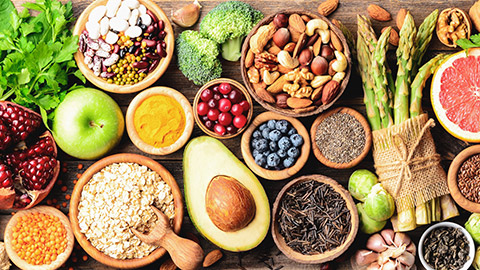
Vitamin B
Vitamin B is in whole grains, meat, fish, and dairy products. The B-complex vitamins are a group of 8 vitamins, which include:
- Thiamine (B1)
- Riboflavin (B2)
- Niacin (B3)
- Pantothenic acid (B5)
- Pyridoxine (B6)
- Biotin (B7)
- Folic acid (B9)
- Cyanocobalamin (B12)
Benefits from B-group vitamins include:
- Aids in stress relief (B1, B2, B3, B6 and B12)
- Strengthens the brain function
- Directly impacts energy levels
- Helps prevent or fight infection
- Aids in the breakdown of fats and proteins (aids nervous system functioning)
- Aids in muscle tone in the stomach and intestinal tract
- Maintenance of skin, hair, eyes, mouth, and liver
- Aids in the breakdown of carbohydrates into glucose (this provides energy for the body)

Vitamin C
Vitamin C is essential for forming connective tissue and hormones, is an antioxidant, and increases iron absorption. It's found in citrus fruits and green vegetables. We are unable to synthesise vitamin C, so it must be eaten. Benefits from Vitamin C:
- Boosts immunity
- Aids in managing high blood pressure
- Improves the skin complexion and protects it from free radicals
- Helps in preventing gout with the reduction of uric acid levels in the body
- Prevents anemia as it assists in iron absorption in the body
- Reduces the risk of chronic diseases including heart disease
Vitamin A
Vitamin A promotes better vision, cell growth, and resistance to bacterial infection. It is found in liver, milk, breakfast cereals, green vegetables, and carrots. Benefits include:
- Assists with maintaining healthy vision
- Aids in healthy skin, bones and other tissues in the body
- Vitamin A is an antioxidant, fighting cell damage from free radicals
Vitamin D
Vitamin D facilitates the absorption of calcium and phosphorous into bones. It is found in milk, breakfast cereals, fish, and sunlight. Benefits include:
- Maintains the health of bones, teeth and muscles
- It can reduce the risks of cancer when taken alongside calcium
- Reduces cardiovascular build-up, reducing cardiovascular disease
- Supports pregnancies by preventing pre-eclampsia and gestational diabetes
Vitamin E
Vitamin E is an antioxidant. It protects from damage from oxygen radicals and toxic chemicals and assists with forming haemoglobin. It is found in vegetable oils, breakfast cereals, fruit and vegetables, and nuts. Benefits include:
- Slows down the ageing process of all cells in the body
- Repairs cell damage done by UV rays
- Prevents the risk of diseases such as heart disease and cancer
Vitamin K
Vitamin K makes protein for the formation of normal blood clots and bone formation. It is found in green vegetables, meats and dairy products. Benefits include:
- Makes proteins for healthy bones
- Regulates blood calcium levels
- Improves memory
Fortified food and supplements
When vitamins from food are difficult to obtain or are insufficient in amount, people may have supplements and fortified foods to meet their nutritional needs. Bear in mind that as a personal trainer you cannot diagnose any nutrient deficiencies, but you can recommend clients to see their doctor if you suspect a nutrient deficiency based on nutritional data you may have collected.
Supplements
Supplements are synthetic versions of vitamins naturally found in the food we eat. They generally would come in pill or liquid form and are taken orally. It is generally accepted that vitamins are best absorbed with real food as it has less risk of exceeding the RDA, but there are some vitamins that can be difficult to achieve through diet alone, especially in certain areas of the world.
Fortified foods
Fortified foods contain vitamins that have been added in during processing. Fortified food enriches foods with additional macro- or micronutrients to supplement dietary deficiencies. These can be important for many populations and foods have often become fortified because of population research finding nutritional gaps in populations. For example, vitamin B12 and calcium fortification of plant-based milks for people choosing to avoid or having intolerances to dairy products; iodine fortification of salt, as this was highlighted as a nutrient of concern in New Zealand for all populations; as well as iron and vitamin D added to many breakfast cereals on the market to ensure adequacy amongst certain demographics of the population.
Fortification is an important public health strategy to ensure everyone at every life stage and socioeconomic status is able to meet their nutritional needs.
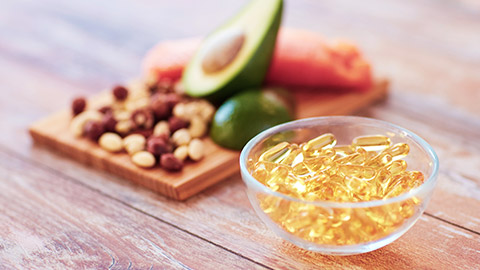
In New Zealand, $30 million is spent on supplements yearly. People take supplements for various reasons, including:
- Cold and flu preventative
- Improve general health/wellbeing
- Friends taking them
- Suggested by pharmacy/store
- Marketing (e.g., paid articles in magazines)
Studies show:
- No benefit in taking additional supplements unless diagnosed with deficiencies
- Vitamin supplements have no benefit for those who are able to consume a wide variety of healthy foods achieving more than the minimum requirements from the ministry of health food groups
- MOST nutrients are best absorbed from food and phytochemicals (plants), but when needed, supplements are useful
- Supplements can be harmful in toxic amounts – especially fat soluble vitamins
- Supplements can be expensive, but for some people a necessary cost if recommended by medical professionals
- MOST nutrients can be gained from a varied diet, with some exceptions
Minerals are naturally occurring inorganic elements that are important in the structure and function of the body. They provide strength in bones and teeth, and maintain the bodily fluids in and around the cells. Minerals are also useful in converting food into energy. There are recommended daily allowances (RDA) and dietary intakes (RDI) for minerals, so we must be aware of these to avoid toxicity from overdosing.
Major and trace minerals
Minerals are required in the diet as the body does not produce them naturally. There are 2 main minerals to be aware of:
- Major minerals (macrominerals)
- Trace minerals (microminerals)
Major minerals are needed in our diet in larger amounts while trace minerals are needed in smaller amounts.

Let’s have a look at the major minerals and trace minerals, what they do in the body (their functions), and their sources.
Major minerals

Sodium
Sodium is required for the initiation of nerve signalling and muscular contraction. It also determines the level of water in the body (extracellular). It is one of the main ingredients in salt. However, there is enough sodium in food that there is no need to add salt. Salt is used for personal preference in taste within a meal but is not a necessity. A good tip to follow when cooking is to taste the food before adding salt, stock, and sauce mixes when cooking. If you do use salt, choose iodised salt.
Sodium is found in table salt, salted meats, frozen dinners, canned beans, olives, cheese, sauces and salted nuts.
Chloride
Chloride is a major electrolyte, vital in balancing fluid in the human body, particularly the fluid composition inside and outside the cells. It is an essential part of fluids (stomach acid) during the digestive process and gets flushed out of the body through urine. Chloride also assists in maintaining optimal blood volume, blood pressure and the pH of the cells within the body.
Chloride can be found in table salt or sea salt as sodium chloride, seaweed, rye, tomatoes, lettuce, celery, olives and salt substitutes (normally chloride is combined with potassium).
Phosphorus
Phosphorus works alongside calcium and together they assist with keeping teeth and bones healthy and supports their structure and formation. It contributes to the growth, maintenance, and repair of tissue cells and aids with providing energy to the cells. You might not be aware that our clever body uses our kidneys to control the amount of phosphate in the blood and the excess is expelled through urine.
Phosphorus can be found in meat, fish, poultry, eggs, milk and processed foods (including soda).
Sulphur
Sulphur helps metabolise food and helps maintain the integrity of skin, tendons, and ligaments. It strengthens hair, skin, and nails and repairs damaged cells. It can be obtained from garlic, onions, eggs, and protein-rich foods
Calcium
Calcium plays a very important role in forming and maintaining strong and healthy bones and teeth. This is a vital mineral, particularly for young children and adolescents as their bone growth and formation continue to approximately 20 years old. It is also important to consider the elderly, who are more susceptible to conditions of bone wasting such as osteoporosis and osteoarthritis.
Calcium is found mainly in milk and dairy products such as yoghurt. It is also found in nuts and leafy green vegetables – such as broccoli and cabbage but not spinach.
Potassium
Potassium is another electrolyte that can assist in balancing the body’s fluids. In this case, it assists in preventing a fluid build-up (water retention) and reducing blood pressure in the body. Potassium plays a vital role in physiological processes such as nerve transmission, cellular signalling, nerve conduction and muscle contraction. It also plays a role in reducing the likelihood of muscle loss.
Potassium can be found in bananas, raisins, apricots, oranges, avocadoes, dates, watermelon, prunes, broccoli, spinach, carrots, potato, sweet potato, mushrooms, peas, lentils, dried beans, peanuts, milk, yogurt, lean meats.
Magnesium
Magnesium is quite a multi-functional mineral and is responsible for protein synthesis, which helps maintain the health of all our cells in the body. Since magnesium is also responsible for energy metabolism, regulating nerve transmission and muscle function, a lack of magnesium can result a decreased appetite, poor body coordination and muscle spasms. Benefits of magnesium include:
- increases performance levels
- alleviates and assists people who suffer from migraines
- alleviates depressions
- is an anti-inflammatory
- regulates muscle contraction and nerve transmission
- assists in regulating blood pressure
Magnesium can be found in soya beans, yeast, whole-grains, nuts, meat, milk, fish, raisins, potatoes, and vegetables (leafy greens)
Trace minerals
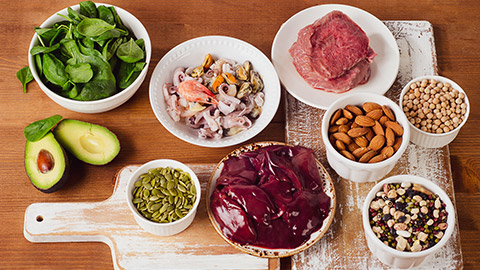
Zinc
Zinc supports physiological functions such as tissue growth and repair. It is a constituent of digestive enzymes and plays a role in your sense of taste and smell. Zinc is also vital for human growth and development, particularly during foetus formation during pregnancy.
Zinc can be found in some seafood (especially shellfish), animal products, cashews, peanuts, and almonds.
Iron
Iron helps transport O2 around the body. Iron aids in the attachment of O2 to the Haem portion of the blood, enabling oxygen to be transported from the lung to the body tissues via the blood and blood vessels. If insufficient amounts of iron are consumed, this can result in impacting the oxygen levels within the muscles, preventing them from functioning optimally.
There are 2 different types of iron. These are:
- Haem: Easily absorbed by the body
- Non-haem: Not absorbed as well as haem iron by the body.
Haem is only found in meat, chicken and fish. Non-haem is found in plant foods, such as vegetables, cereals, beans and lentils.
Molybdenum
Molybdenum's main function is to prevent toxins from building up in the body and activate the enzymes that break those harmful toxins down. The kidneys help regulate molybdenum in the body and excrete the excess through the urine tract.
Molybdenum is found in milk, cheese, cereal grains, legumes, nuts, leafy vegetables and organ meats
Manganese
Manganese aids in removing toxins and activating the enzymes that break them down, much like Molybdenum. Manganese is required for the normal function of the brain, nervous system and many other enzyme processes in the body, as well as metabolising nutrients, cholesterol, and carbohydrates. The body stores manganese; however, it does not produce it. Therefore, it needs to be gained through diet. Manganese is only required in small amounts.
Manganese can be found in whole grains, oysters, mussels, nuts, rice, leafy vegetables, coffee, tea, and many spices e.g., black pepper.
Selenium
Selenium produces antioxidant enzymes that help in preventing cell damage and boosts immunity to prevent illnesses or other infections from viruses. Selenium is also a key support in maintaining physiological functions such as a healthy immune system, optimal cognitive function and fertility in both males and females.
Selenium can be found in organ meats such as liver, yoghurt, seafood, brazil nuts, grains and cereal.
Chromium
Chromium stimulates fatty acids in the stomach and the synthesis of cholesterol. As a result, it helps to break down fats and carbohydrates when ingested. For this reason, chromium controls glucose levels as it breaks down carbohydrates which are highly beneficial for diabetic glucose control and may also aid in weight loss.
It is found in milk, dairy, vegetables, whole-grain, liver, beef, poultry, and fruits.
Fluoride
Fluoride plays a role in developing strong and healthy bones and teeth. Minimal sources contain fluoride, those which do typically obtain the fluoride from the water they were cooked in.
Fluoride can be found in fluoridated water, tea, sardines and prawns, grape juice, jelly, soda and raisins.
Iodine
Iodine assists in the production of thyroid hormones that help balance the body’s metabolism, which influences weight gain and loss. Thyroid hormones also aid in functions contributing to the growth of bones and brain development of a foetus during pregnancy.
Iodine is found in fish, seaweed and other seafood, dairy products, cereal and grain foods, fruits, vegetables (depending if the soil, is iodised), iodised salt and processed foods.
Copper
Copper plays a major role in the growth, development, and maintenance of the brain, connective tissue, bones, the heart, and other body organs. Since it influences so many aspects of the health of the human body, it is not hard to see that it will contribute immensely to preventing serious illnesses and diseases such as heart disease or osteoporosis. In addition, copper also supports the performance of essential metabolic functions in the human body.
Copper is found in liver, seeds, nuts, leafy greens, organ meats, oysters, and dark chocolate.
Hydration is a critical component of nutrition principles that should not be overlooked. While macronutrients are essential for providing energy and building blocks for the body, and micronutrients are required for various physiological processes, hydration is necessary for maintaining overall health and wellbeing. Proper hydration is essential for regulating body temperature, lubricating joints, transporting nutrients and oxygen throughout the body, and removing waste products.
This subtopic will explore the importance of water for optimal health, daily recommendations, and the consequences of dehydration. Understanding the role of hydration in nutrition principles is crucial for maintaining a healthy diet and lifestyle.
| Fluid | A broad term encompassing any liquid substance. It's important to note that the term "fluid" cannot replace "water". This is because all fluids that are drunk contain water, but not all fluids hydrate as well as water. |
| Diuretic | An agent which increases urine production and excretion. Caffeine and alcohol are both diuretics. |
| Extracellular fluid (ECF) | The fluid outside the cells. This makes up about 35% of the total body water. ECF can be divided into 2 compartments: the intravascular space (fluid in blood vessels) and the interstitial space (fluid between cells). |
| Electrolytes | Acids, bases, and salts. Includes sodium, potassium, and calcium. These activate enzymes to control various metabolic processes or generate nerve impulses. |
The importance of hydration
Homeostasis
Maintaining a good hydration level is critical to the body’s temperature control process. Body water loss through sweat is an important cooling mechanism in hot climates and during physical activity.
Evaporation of sweat from the body results in the cooling of the skin. However, if sweat loss is not compensated for with fluid intake, especially during intense physical activity, this results in a hypohydration state which can lead to an increase in body core temperature.
Blood flow and consistency
Maintaining adequate hydration allows the blood to flow easily without becoming sticky. This allows for a sufficient supply of oxygen and the removal of waste products from the muscles and helps transport heat to the skin's surface.
Overall benefits
Maintaining adequate hydration levels:
- reduces the risk of heat illness.
- maximises performance by preventing or reducing dehydration.
- reduces stress on major organs whether at rest or during exercise.
Daily recommendations
So, then how much water should we be drinking each day?
Watch the video from Healthline about how much water we should drink daily and then answer the questions.
So, what is the answer?
The answer is that it is an individual amount depending on your size, age, the environment you are in, and the activity you are doing. Under normal conditions, water loss equals about 2,500 mL (or 2.5 L) per day. However, as higher environmental temperatures and exercise are added, the water loss can increase dramatically up to 6 or 7 litres a day!
Fluid recommendations
Pre-exercise
Drink 400-600 mL of fluid over 2-3 hours before exercise. 10-15 minutes before exercise you should have pale urine.
During exercise
Drink 150-300 mL per 15 minutes of exercise (depending on environmental factors and exercise intensity).
Recent research suggests that ultra-distance athletes competing at relatively low intensities or smaller athletes with relatively low metabolic and sweat rates may require smaller volumes.
Fluid needs may also vary depending on the activity mode (mainly due to comfort and fluid availability). Can you give an example of when the mode of activity might restrict fluid consumption?
Long-distance running or endurance events are examples where fluid needs might be restricted because stopping to drink fluids may not be practical or may slow down performance. Athletes may be limited in the amount of fluid they can consume due to the practical difficulties of carrying and consuming fluids while on the move. Additionally, consuming too much fluid during endurance events can cause gastrointestinal distress, which can negatively affect performance. As a result, athletes may need to carefully manage their fluid intake to ensure they remain hydrated without over-consuming fluids.
It is best to ingest carbohydrates and fluid together as it takes almost 3 mL of water to metabolise one gram of carbohydrate.
Post-exercise
Following exercise, continue to drink fluid at a rate above normal. 1 – 1.5 x the amount of body weight lost is ideal. This allows for continued loss through urine and sweating after the event. You will only know the required amount if you weigh yourself before and after exercise. Also simply drinking to thirst works as well!
Hydration outcomes
When it comes to hydration, there are 3 possible outcomes:
- Get it right: Appropriately prepared and hydrated before, during, and after exercise.
- Not having enough: Leading to a hypo-hydrated state, i.e., dehydration.
- Consuming too much fluid (water in particular): Leading to a hyperhydrated state, i.e., over-hydrated and hyponatremic.
Dehydration
Dehydration is a lack of fluid in your body. Conservative estimates suggest the body is at least 65% water. Most of this water is "in cells" (intra-cellular) and 25-35% of your body water is extra-cellular. Your blood is also predominantly water.
Dehydration occurs when water loss outweighs water intake.
Factors that can influence the rate at which fluid is lost from the body:
- Environmental heat and humidity
- Exercise-related heat production and removal
- Elevated breathing rates
- The amount you urinate
- Illness or condition (especially if associated with vomiting, diarrhoea or fever)
- Lactation (breastfeeding)
When exercising your body temperature increases due to increased metabolic rate. To off-load excess heat and maintain normal body temperature the body sweats. When sweat evaporates from the body, heat is lost, but so are essential body fluids. Evaporation accounts for about 25% of heat loss at rest and 85% during exercise. The body cools down, but cooling comes at a cost if these fluid losses are not replaced.
Avoiding hyponatraemia (over-hydrated or water intoxication)
Hyponatremia is a medical condition characterised by low sodium levels in the blood, typically defined as a serum sodium concentration of less than 135 mEq/L (normal levels are between 134-145mEq/L). Sodium is an important electrolyte that helps regulate fluid balance in the body. Low sodium levels can disrupt normal cellular function, blood pressure regulation, nervous system pathways, and muscle contraction.
Hyponatremia can occur due to excess fluid intake, kidney dysfunction, certain medications, and hormonal imbalances. Common symptoms of hyponatremia include nausea, weakness, lack of coordination, headache, confusion, seizures, and in severe cases, coma or death. You may notice many of these symptoms are consistent with heat illnesses, so people are often treated with aggressive hydration, which is the last thing they need!
The treatment of hyponatremia depends on the underlying cause but may involve fluid restriction, sodium supplementation, or medication to correct electrolyte imbalances.
One strategy to avoid hyponatraemia is to drink to thirst.
Taking in 300–800 mg/L of fluid can help to offset salt losses, minimise muscle cramping, and lower the risk of hyponatremia. Measuring sweat rate is important to customise the sodium requirement.
Athletes engaged in prolonged exercise (e.g., marathon runners) should ingest 1g/hour of sodium. Most sports drinks do not contain the recommended levels of electrolytes but can still be useful in preventing the onset of hyponatraemia. Many professional teams now realise the importance of hydration in their athletes to allow peak performance during training.
Another strategy would be measuring water lost in sweat! You would need to weigh yourself before and after exercise during a range of different trainings and environments to work out how these things affect your body's sweat production. If you were logging this information regularly, you would build a decent picture of your body's specific fluid needs for exercise and be able to plan to match those sweat losses with fluid during the session.
Hydration check-in
If you're thirsty, now would be a good time to drink some water.
